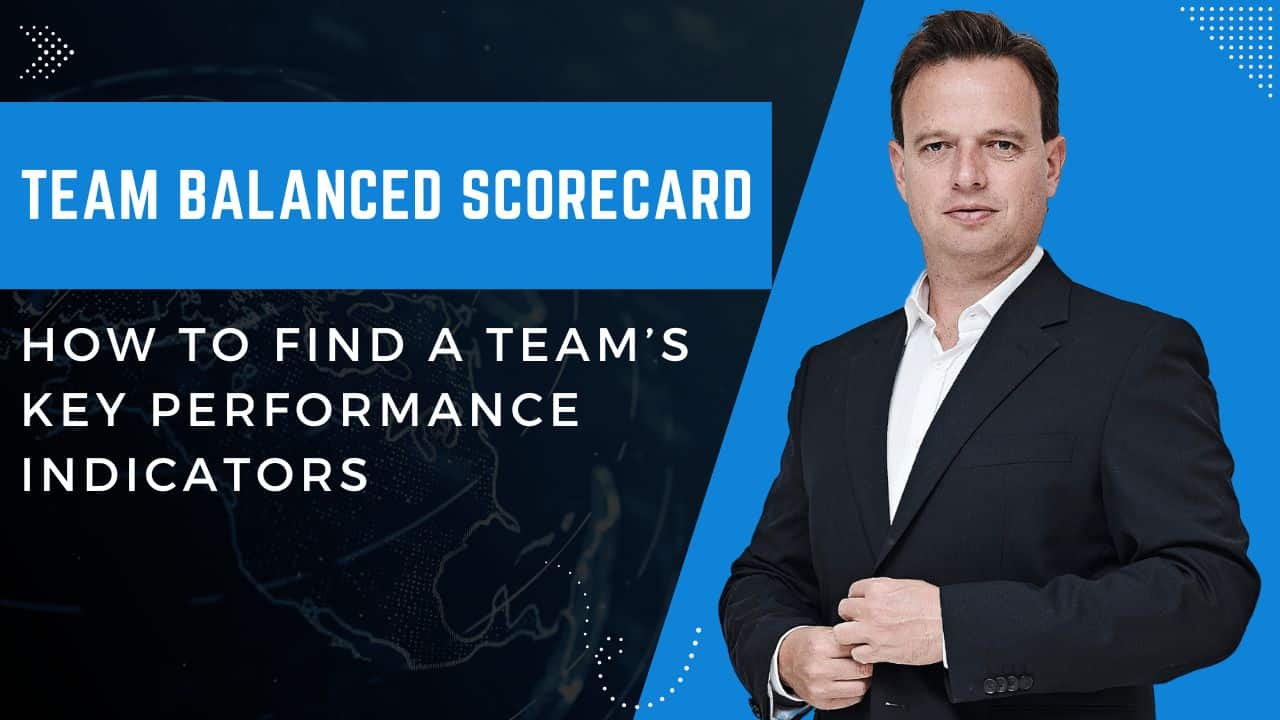Teams can get fixated on a single measure of performance.
To perform at the top of their game, however, it’s best to monitor a balanced range of indicators to fulfil their purpose.
This Balanced Scorecard workshop (adapted for teams) helps them find their best set of key performance indicators (KPIs) and provides a method for identifying specific measures and goals.
Commonly, it’s a process used at an organisational level.
However, I’ve found it highly effective at the team level after they have nailed down their purpose/vision.
Below is my process for a Team Balanced Scorecard you won’t find anywhere else.
The benefits of this workshop are:
- You create a framework for measuring performance using both financial and non-financial metrics. This approach prevents teams from focusing solely on short-term financial results at the expense of long-term sustainability.
- It translates strategy into action by breaking strategic objectives into actionable measures and initiatives.
- It highlights areas of strength and weakness, allowing the team to allocate resources effectively.
Some training companies charge thousands of dollars for you to earn a Balanced Scorecard Professional Certification over multiple days.
I like simplifying complicated processes so anyone can run them and give them to you for free.
Here’s how it works, step-by-step:
Objective
To create a picture of your team’s performance relative to the team’s vision, strategy and purpose in four main areas: Financial, Internal, Learning/Growth and Customer/Stakeholder.
Pre-work
You should arrive at your workshop with the following information:
- The team’s strategic plan/vision.
- How the team is currently structured and operating.
- The skill and expertise of team members.
- The current customer/stakeholder satisfaction level.
Step 1: Set Team Vision and choose Perspectives
Establish or confirm the team’s vision related to the wider organisation.
Identify the perspectives for measurement that are clear and understandable for your team.
The original model uses four:
- Financial - Focus on traditional financial metrics that reflect the team's financial performance and success. Key indicators may include revenue growth, profitability, return on investment (ROI), and cash flow.
- Internal - Focus on the internal processes and operations. This involves identifying key processes, improving efficiency, reducing costs, and enhancing quality. Key indicators may include cycle time, defect rate, process improvement initiatives, and operational efficiency.
- Learning/Growth - Focus on the team's ability to innovate, learn, and grow over time. It involves developing employees' capabilities, fostering a culture of learning and innovation, and investing in training and development. Key indicators may include employee satisfaction, skill development, employee turnover rate, and innovation metrics.
- Customer/Stakeholder - Focus on customer/stakeholder satisfaction. Key indicators may include customer loyalty, market share, customer acquisition costs, and customer/stakeholder satisfaction scores.
Feel free to add others, but I recommend you start with these four.
Step 2: Fill in Strategic Aims, CSFs and Strategic Measures
Break the team vision down according to each perspective, and first agree on your Strategic Aims.
For each Perspective, ask the question:
- “For our Team Vision to succeed, how will we differ?”
Here’s an example of a Scuba Diving Center:

Then, identify the critical success factors (CSFs) by asking this question for each Perspective:
- “What are the critical success factors for achieving our Strategic Aims?”
Here’s what our Scuba Center came up with:

Finally, develop Strategic Measures to evaluate those factors. Ask this question for each Perspective:
- “What measurements (or KPIs) will prove we’re on the right track?”
Again, let’s see what our Scuba Center agreed on:

Before jumping to the final step, analyse the measures as a team to ensure they provide a ‘balanced’ picture.
Step 3 - Develop an Action Plan
- Take the scorecard and create more detailed cards (on Post-Its), translating strategy to day-to-day tasks.
- Formulate goals for every measure used. Ensure there are both short and long-term goals.
- Develop an action plan to achieve the goals and strategy set like our Scuba Diving friends did here...

Conclusion
As with all workshops, the inclusive process of developing a scorecard is as valuable as the scorecard itself.
So make sure you have everyone in the room before you start.
Success depends on creating a shared understanding of each scorecard dimension.
You should not try to shoehorn existing measures into the scorecard.
Instead, take the opportunity to examine the team from a blank canvas and develop both financial and non-financial measures accordingly.
Ensure all your Strategic Measures are SMART (Specific, Measurable, Realistic and Timely) – you can’t improve on things you can’t measure.
Remember, the Team Balanced Scorecard is a workshop that enables teams to monitor and manage performance in a balanced and integrated manner.
Well, that’s it for today.
I hope you enjoyed it.

